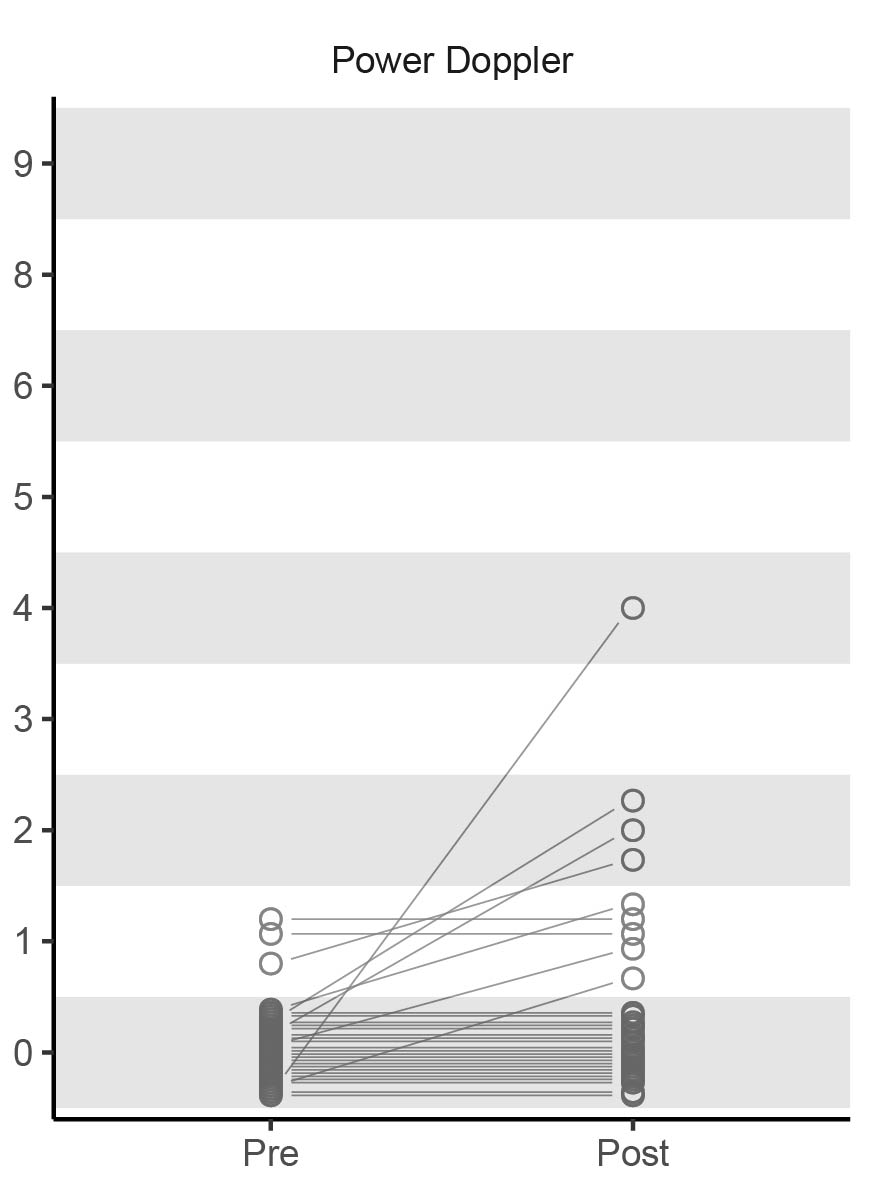Session Information
Session Type: Poster Session D
Session Time: 9:00AM-11:00AM
Background/Purpose: Biomechanical stress triggers entheseal inflammation in psoriatic disease [1,2]. However, there is only limited data on the impact of mechanical stress on entheseal sites in healthy subjects. Musculoskeletal ultrasound can detect acute inflammatory changes at entheseal sites using power doppler (PD) technology. Competitive badminton is a demanding stop-and-go sport that puts strain especially on entheseal sites and is therefore an ideal sport to assess the impact of physical activity on the synovial-entheseal complex. Thus, we aimed to test whether intensive pyhsical stimulation of the musculoskeletal system by badminton training leads to an immediate inflammatory response at entheseal sites measured by PD ultrasound.
Methods: In this interventional study (BEAT, Badminton Enthesitis Arthrosonography Study), competitive players from two different badminton clubs were recruited. Only subjects without chronic inflammatory diseases were included. A physical examination comprising an examination of 29 entheses (SPARCC, LEI, MASES) of all players was performed just before and after 60 minutes of intensive training. Ultrasound of entheseal sites (achilles tendon, patella tendon at the tibial insertion, epicondylus humeri lateralis; all both sides) was also performed immediately before and after the training by an independent assessors using a Samsung HS50 machine with a linear probe (16 MHZ). The presence of inflammatory entheseal components was assessed using a validated scoring system. [3] Scores at each site were summed to derive an empirical total score for each participant for visual comparison. Pre- and post-match scores were compared using linear mixed effects models. We used interaction terms to assess possible differential effects on patella, elbow or achilles entheses. The study was approved by the ethics committee and all subjects provided informed consent.
Results: 32 players (22 men, 10 women) with an average age of 31.1±13.0 years were included. On average they had been playing badminton for 16.2±10.1 years. 192 entheseal sites were examined twice. The respective empirical total scores for PD examination were 0.1 (0.3) before and 0.5 (0.9) after training. Overall 7 participants (22%) showed an increased empirical total PD score as shown in the figure. A mixed effects model shows that there was an increase in PD scores after the game, with a mean increase per region of 0.06 (95%CI 0.01 to 0.12, p=0.017).
Conclusion: Ultrasonographic assessment of entheses after an hour of high-impact exercise in healthy individuals show a significant increase in PD activity at entheseal sites. The magnitude of these changes however seems rather small and only in a subset of individuals. However, these results underline the concept of mechano-inflammation and needs to be further assessed in a population with known risk factors for developing spondyloarthritis or psoriatic disease. Linearity assumption for the bounded discrete ultrasound scores is a shortcoming of this analysis.
[1] Solmaz D. Et al., Arthritis Rheumatol. 2018; 70 (suppl 10).
[2] Schett G. et al., Nat Rev Rheumatol. 2017 Nov 21;13(12):731-741
[3] Balint PV. et al., Annals of the Rheumatic Diseases 2018;77:1730-1735.
To cite this abstract in AMA style:
Simon D, Kleyer A, Tascilar K, Bayat S, Knitza J, Valor-Mendez L, Schweiger M, Schett G, Hueber A. High Impact Sports Leads to Inflammatory Responses at Entheseal Sites Results of the BEAT Study (Badminton Enthesitis Arthrosonography Study) [abstract]. Arthritis Rheumatol. 2020; 72 (suppl 10). https://acrabstracts.org/abstract/high-impact-sports-leads-to-inflammatory-responses-at-entheseal-sites-results-of-the-beat-study-badminton-enthesitis-arthrosonography-study/. Accessed .« Back to ACR Convergence 2020
ACR Meeting Abstracts - https://acrabstracts.org/abstract/high-impact-sports-leads-to-inflammatory-responses-at-entheseal-sites-results-of-the-beat-study-badminton-enthesitis-arthrosonography-study/

